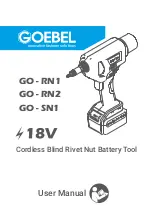
6
General Instructions For All Power Tools
• Do not overreach . Keep proper footing and balance at all times .
• Maintain tools with care . Keep tools sharp and clean for best and safest
performance . Follow instructions for lubricating and changing accessories .
• Disconnect all tools . When not in use, before servicing, or when changing
attachments, blades, bits, cutters, etc, all tools should be disconnected from
power source .
• Reduce the risk of unintentional starting . Be sure switch is off when plugging in .
• Use recommended accessories . Consult the operator’s manual for
recommended accessories . The use of improper accessories may cause
risk of injury .
• Never stand on tool . Serious injury could occur if the tool is tipped or if the drill
is unintentionally contacted .
• Never leave tool running unattended . Turn power off . Don’t leave tool until it
comes to a complete stop .
• Check damaged parts . Before further use of the tool, a guard or other part that
is damaged should be carefully checked to determine that it will operate prop-
erly and perform its intended function . Check for alignment of moving parts,
binding or moving parts, breakage of parts, mounting and any other conditions
that may affect its operation . A guard or other part that is damaged must be
properly repaired or replaced by an authorized service center to avoid risk of
personal injury .
• Protect your hearing . Wear hearing protection during extended periods of
operation .
• Keep tools dry, clean, and free from oil and grease . Always use a clean cloth
when cleaning . Never use brake fluids, gasoline, petroleum-based products, or
any solvents to clean tool .
• PROTECT YOUR LUNGS . Wear a face or dust mask if the operation is dusty .
• Guard against electrical shock by preventing body contact with grounded
surfaces . For example: pipes, radiators, ranges, and refrigerator enclosures .




































